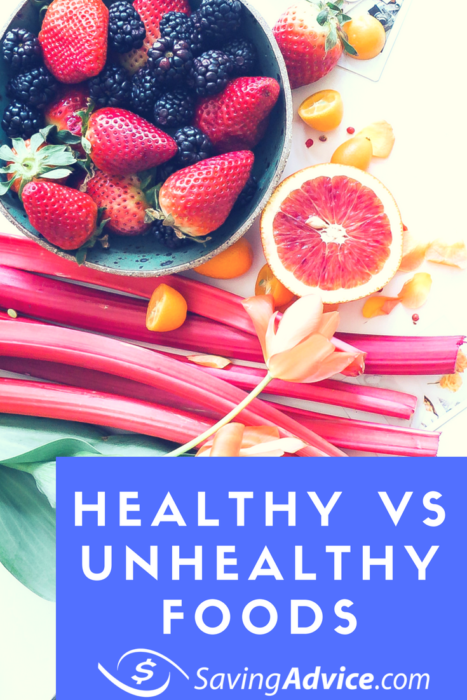
The Cost of Eating Healthy
Organic foods can be somewhat expensive. These foods are touted to maintain a healthy diet. These organic diets are rich in fruits, veggies, fish, and nuts. The healthiest of diets cost around $1.50 or more per day than the least healthy, according to research from the Harvard School of Public Health.
They analyzed data from 27 existing studies. Once the data was collected, they looked at the difference in price per serving, price per 200 calories (for certain foods), price per day, and price per 2,000 calories (the recommended average daily intake).
Overall, it was found that healthy diets cost significantly more than an unhealthy one. This is because some food policies have led to an inexpensive, high-quality approach, making unhealthy food cheap. However, researchers hope their findings will eventually lead to a decline in the prices of healthier foods.
Cost of Poor Eating Habits
Spending $1.50 a day more pales in comparison to the cost of poor or unhealthy eating habits though. Diet-related health diseases include conditions such as heart disease, obesity, Type 2 diabetes, stroke, and some cancers. Each of these leads to more than 700,000 deaths each year. Even more, 1,000 people die each day from heart disease, stroke, and diabetes alone.
The U.S. spends around $3.3 trillion (more than $10,000 per person) on health care each year, accounting for 17.9% of the country’s overall spending. Cardiovascular disease costs the U.S. $555 billion each year.
Diabetes-related spending is estimated to be $327 billion. Strokes account for $34 billion of health care-related costs and obesity-related illnesses are responsible for another $194 billion.
Number of People Living With Diet-Related Illnesses in the U.S.
| Obesity | 78,100,000 |
| High Blood Pressure | 66,900,000 |
| Diabetes | 29,100,000 |
| Heart disease | 26,600,000 |
| Cancer | 20,073,000 |
| Osteoporosis | 9,900,000 |
| Stroke | 6,400,000 |
So, what are millions of Americans supposed to do? Obviously, eating healthy is the right thing to do for your health. But, how do you transition from unhealthy food to healthy eating habits?
Healthy vs Unhealthy Eating Habits
Before you embark on any kind of journey, whether it be changing your eating habits or your financial habits, you should know what you are looking to change. There is some debate as to what is healthy and what’s not though. Whether low-carb diets or a high protein diet is the best is not certain, but it is pretty much agreed upon that the following foods are considered healthy.
- Whole grains
- Lean protein, such as chicken and fish
- Unprocessed red meat
- Low-sodium lunch meats
- Fresh fruits and vegetables
- Fresh leafy greens
- Cold pressed extra virgin oils
- Raw nuts. seeds, and sprouts
- Seaweeds and sea vegetables
- Brown rice
- Whole grain pasta
While some grains and higher carb foods have been added to the unhealthy food list in some circles, the food items below are generally considered to be unhealthy.
- Processed foods like white bread and white pasta
- Refined sugar, high fructose corn syrup, and aspartame
- MSG and other taste-enhancing chemicals should be avoided
- Processed fats and oils
Although the $550 a year price tag is a turnoff, there are a plethora of benefits when it comes to eating healthy vs unhealthy.
Boosts Your Immunity
A nutrient-rich diet helps your body fight diseases and ensures it obtains immune-boosting nutrients like omega-3 fatty acids, iron, and other essential vitamins. Unhealthy foods, on the other hand, increase toxicity levels in your body. This weakens your immunity.
Higher Energy Levels
Eating healthy ensures a stable supply of energy all day long. Those who eat diets high is bad fats, processed food, and sugar are set up for a crash. It leaves you feeling sluggish by early afternoon.
Maintain Your Weight
A healthy diet boosts your metabolism. This can help you lose weight if you’ve been looking to lose. It can also help with digestion issues and help your body burn fat, wheres unhealthy foods lead to the storing of fat in the body. For individuals seeking professional guidance on nutrition and metabolic health, consulting a mounjaro dietitian can provide tailored support for sustainable weight management and improved overall wellness.
Emotional Well-Being
A nutrient-rich diet will have you feeling energetic all the time. This helps your emotional wellness. When you have energy and feel happy, you get out more and interact with others, and this all supports a healthy mental state. Eating a poor diet can cause vitamin deficiencies that leave you feeling tired throughout the day.
All in all, to make a real difference in your life health-wise, you’ll need to drop your unhealthy eating habits. Even though it costs a bit more, think about everything you stand to gain from it. You can shield yourself from the cost by shopping at places like Aldi, Costco, or keeping an eye out for coupons. Eating healthy will have you feeling better and possibly save a boatload in health costs.
Give the gift of savings! Learn more
Read More
- Cheap Paleo Diet Plan and Recipes
- The Best $50 Grocery List
- One Week Aldi Meal Plan
- How Much Do You Save (or Spend) After You Lose Weight?
- How to Eat Organic While Buying Cheap Healthy Food
- 5 Health Savings Account Rules That Might Surprise You
- Diet Bet: Lose Weight and Save Money in the New Year
- Low-Carb Diet Best for Managing Blood Sugar: Study
- Vegetarian Diet Proven as Effective as Mediterranean Diet
- Can the DASH Diet Cut the Risk of Depression?

Amanda Blankenship is the Chief Editor for District Media. With a BA in journalism from Wingate University, she frequently writes for a handful of websites and loves to share her own personal finance story with others. When she isn’t typing away at her desk, she enjoys spending time with her daughter, son, husband, and dog. During her free time, you’re likely to find her with her nose in a book, hiking, or playing RPG video games.
Comments